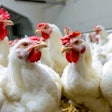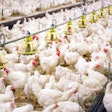
The growing flexitarian style of eating would seem to be a curse to the meat and poultry industry. It encourages eating plant-based foods while allowing meat and other animal products in moderation. So, is flexitarian a dirty word for meat marketers?
Not necessarily, said a speaker at Chicken Marketing Summit 2019. Meagan Nelson, associate director of the fresh growth and strategy team, Nielsen, said meat (especially chicken) is formidable and resilient – due in part to its relative affordability.
Chicken is especially well positioned to successfully compete in today’s protein-hungry market.
“Chicken, pork and turkey cost the least per gram, at 2 cents, well below the 10 cents for meat alternatives, 13 cents for nuts and 20 cents for nutrition bars.” she said.
“Plant-based protein alternatives,” she said, “will not be the demise of traditional meat. Meat and meat alternatives can co-exist.”
Still, flexitarian eating and plant-based proteins are a lasting trend. Plant-based options abound with 15% of food and beverage dollars come from products that meet a plant-based diet, up 1.6% from last year.
A protein perception problem
Meat and poultry marketers, however, have work to do in positioning their products. Consumers, for the most part, don’t understand meat and poultry’s high protein content nor its affordability, Nelson said.
Consumers, for example, tend to under appreciate chicken’s high protein level. Only 42% of consumers surveyed identified chicken breasts as a high protein food with greater than 20 grams per ounce of the nutrient. That’s up 4 points from the prior year for chicken breasts, while consumers’ identification of pork loins as a high protein content food fell to 36%.
Nelson concluded that there’s a protein perception problem for all meat proteins including chicken. In the current, protein-centric market that represents either a problem or an opportunity in the battle for the flexitarian food dollar.
Meat and poultry’s protein value is also underappreciated.
“Chicken, on average, is the lowest priced per gram of the proteins on the market,” she said. “That’s important in this space where even the Baby Ruth candy bar carries a grams-of-protein claim on the label.”
Flexitarian: New market reality
Chicken marketers must be innovative and develop unique product applications to win the battle for the consumer’s protein dollar in this new market space.
“The protein landscape today and going forward will be defined more by the word ‘and’ than ‘or,’” Nelson said.
Nearly all (98%) of meat alternative buyers also purchase meat, and they do so more than the average meat buyer ($486 vs. $478 per year).
“If we define flexitarian as medium and heavy buyers of both meat and meat alternatives, they account for 37% of all meat alternative buyers and they spend $643 on meat every year – a whopping $165 more per year than the average meat buyer.”
How will flexitarian eating impact meat and poultry sales? Nelson said that as social consciousness and activism continues to accelerate, social causes can drive action.
What are consumers willing to do to alter livestock’s impact on climate change? According to Nielsen data, consumers indicate a willingness to take the following actions:
- Reduce meat consumption: 61%
- Replace meat-based protein with plant-based protein alternatives: 43%
- Become vegetarian or vegan: 22%
- I do not think changing meat consumption habit will have a measurable impact: 15%
- Eat cell cultured meat grown in a lab: 12%
- Replace meat-based protein with bug/insect-based protein alternatives: 8%
Which proteins will win the battle for the consumer’s dollar? With new innovations, health and wellness and social considerations, plant-based foods will continue to shine and grow. Plant-based alternatives, however, will not be the demise of traditional meat. Meat and poultry marketers have a strong sales proposition to answer the “flexitarian” demand.
















